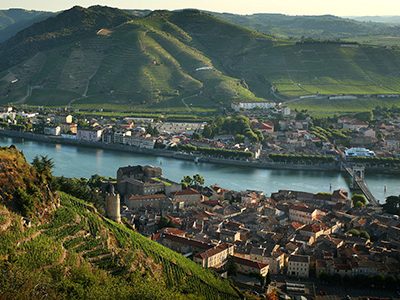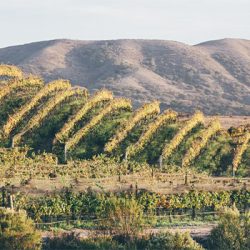Travel east out of the Wachau and you’ll cross streams that give their names to the neighboring regions of Kremstal and Kamptal. Undulating hills soon shadow the Danube until it dips south toward Vienna. A bulwark of empires since Roman times, those hills have harbored grape vines for almost as long, the terraces carved into a singular soil—an Ice Age gift to growers—that indelibly imprints their wines.
Gold Dust and Grapes
Follow the sunken roads that bisect these hillsides and you’re liable to be plunged into darkness at midday. Welcome to the Wagram! Activate your headlights and find yourself engulfed in the golden glow of what look like mysteriously stable walls of dust. It is dust—ancient dust scoured by glaciers and borne here by relentless winds. Dust with a name: “loess.” You can imagine that burrowing into this stuff must be child’s play for a vine, and direct evidence is everywhere. Occasionally, you’ll even spy pale, ghost-like grape leaves hugging the ceiling of a wine cellar, where a vine, emerging deep underground, became disoriented.
“Wagram” derives from words for waves or water and for a barrier, berm or borderline. It often appears as “Wachrain,” conjuring a line of watch posts, and, in fact, this roughly 25-mile stretch overlooking the Danube served as a tripwire along Rome’s imperial lines. From the moment the name first appears—as “Wagreini” in an 831 deed—it is associated as inescapably with wine growing as with military defense. A thousand years later, the same ecclesiastical grantees still controlled the Wagram’s most profitable slopes. Meanwhile, the Wachau’s steep stone terraces, their role in a flourishing medieval winegrowing culture all but forgotten, were harsh taskmasters whose 19th-century crop ended up mostly as vinegar. What was deposited only in nooks and crannies amid the Wachau’s crags was piled up to 60 feet deep in the Wagram: that magic yellow dust with a vinous destiny.


Photo by Ingo Pertramer
Loess offers moisture-holding capacity, active lime content and permeability: an ideal medium for grüner veltliner, the native grape that overran Austrian vineyards during the last century and a half. “No other Austrian growing region features just a single sort of soil,” avers Martin Diwald, “and that makes Wagram Grüner Veltliner always a bit glossier, creamier, though also piquant.” Many of his fellow winegrowers concur. Any attempt to define the Wagram as an appellation—a project rendered topical by the strenuous efforts of Austria’s wine establishment to cover its country’s viticultural surface with so-called DACs—must take account of this region’s overwhelmingly dominant soil and grape variety. Here, it would seem, is a place whose landscape not only directly influences but also metaphorically reflects the character of its wines.
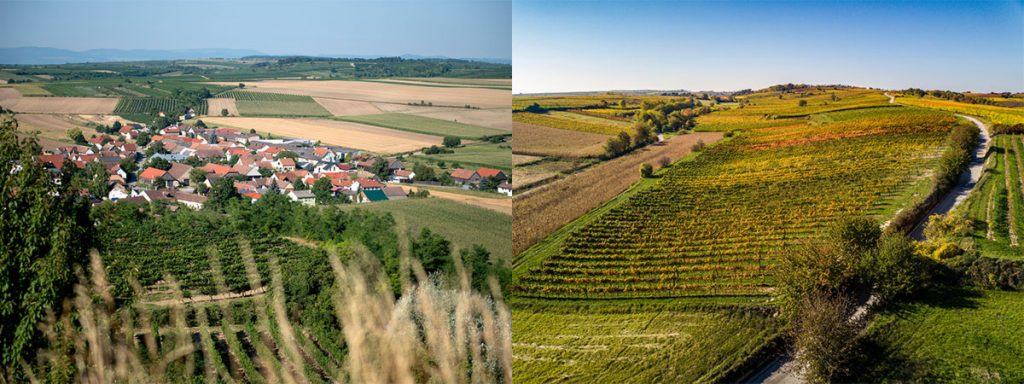

Photo (left) by Roland Kretschmer, right by Martin Diwald
Brenna Quigley, rare among geologists in her willingness to directly associate soil with taste, testifies to Austrian loess as a seminal and compelling instance of common influence across a varietal spectrum. “On nutrient-rich loess soils,” Quigley notes, “you almost always find grüner veltliner. It seems to crave the lushness of loess”—an observation she doubtless made without realizing that when the name “Wagram” came to designate an official wine region, its mouthful of a marketing slogan was Des Grünen Veltliners Lust auf Löss: “Grüner veltliner’s yen for loess.” By contrast, Quigley observes, “Riesling is very adaptable, so there are instances where the two swap [soils]. And you actually get something very similar texturally. From loess, the wines have a shape, kind of like you’re holding rounded, smooth pebbles in your mouth—not soft and squishy, but a beautifully rounded taste.” Occasionally, even growers themselves testify to mistaking riesling for grüner veltliner when both issue from loess, an observation that Quigley credits with prompting her own attempts to explore how soil can shape flavor.
Until 2007, the Wagram labored under an amorphous designation: “Donauland,” a name created in 1971 for a vast swath of viticultural Lower Austria from which, one by one, the Wachau, Kremstal, Kamptal, Traisental and Carnuntum declared independence, leaving as a lonely remnant these once proud hills on the Danube’s left bank (awkwardly linked with a few unrelated sites along the opposite shore). Tasting through a broad cross section of Wagram wines, though, suspicion arises that something else might help to explain this region’s contemporary low profile: Perhaps both growers’ and grüner veltliner’s yearnings are too easily satisfied. What’s smooth can become overindulgent or homogenized. It’s a danger readily acknowledged by Bernard Ott—the closest one comes in the Wagram to a star and the sole Austrian grower of note whose production approaches 90 percent grüner veltliner. But Ott thinks blame is misplaced in terroir. Loess, he insists, especially when humus-enriched and complemented by strategically managed cover crops, represents a viticultural treasure, provided, of course, a grower doesn’t over-crop. Moreover, regardless of grape variety, such a combination is ideal for mitigating the increasingly severe droughts and sporadically torrential rains associated with climate change. If you want proof of loess efficacy, growers will ask you to go looking for drip lines or irrigation pipes. Unlike most of the Wachau and most top sites in the Kamptal and Kremstal, the Wagram is almost entirely dry-farmed. So, whose vines are being over-indulged?
Adaptive Advantages
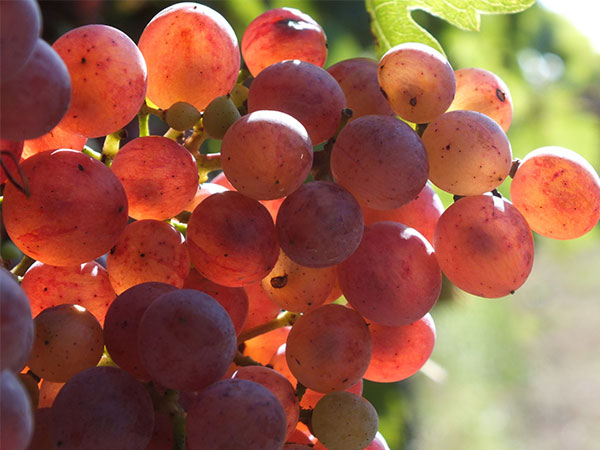

Photo by Bogdan Kordy
It might seem paradoxical in the face of global warming to tout a thirsty grape, not to mention a region warmer in aggregate than its better-known neighbors to the north and west. The farther one travels down the Danube, the weaker the cooling nighttime drafts from Austria’s Waldviertel (“forested quarter”) and the greater exposure to warm air funneled upriver from the Hungarian Plain. But this underestimates the importance of altitude and ventilation. At 1,150 feet above sea level, many Wagram sites farmed by Ott, Diwald and Josef Ehmoser reach higher than such iconic prominences as the Kamptal’s Zöbinger Heiligenstein and the Wachau’s Spitzer Singerriedel, while nearly all of Toni Söllner’s Gösing sites are higher still. Moreover, many of these slopes are capped by woods, providing an additional cooling effect. Among the easily overlooked advantages of altitude in a warming period is that winter temperatures usually remain cold enough for vines to go dormant and pest populations to be frozen out; also, snow will accumulate, so that water is released gradually and not wasted. Hugely important, too, is how open the Wagram’s broad landscape is to prevailing breezes, which further mitigate heat and, when conditions turn humid, ward off fungus.
With grüner veltliner, avers Ott, “the vines have to be free of stress, otherwise any elegance evaporates from the wines.” He admits to finding those that made his own reputation too opulent and creamy, and has added to his vinification regimen features such as crushing, skin contact, slow pressing as if in an old basket press, and long lees contact in large casks, designed, in his words, “to capture the tension, piquancy and precision achievable from grüner veltliner thanks to calcareous loess.” These are quality criteria with which many of the Wagram’s most talented growers—particularly some half dozen who share Ott’s commitment to biodynamics—largely sympathize. Yet, while Ott is convinced that “over the next ten to twenty years, grüner veltliner is going to experience [another] decided leap in international recognition,” with his region in the lead, not all Wagram growers are doubling-down on it: The Wagram has been dealt a wild card that it should not fail to play: a grape genetically unrelated to grüner veltliner while sharing its last name.
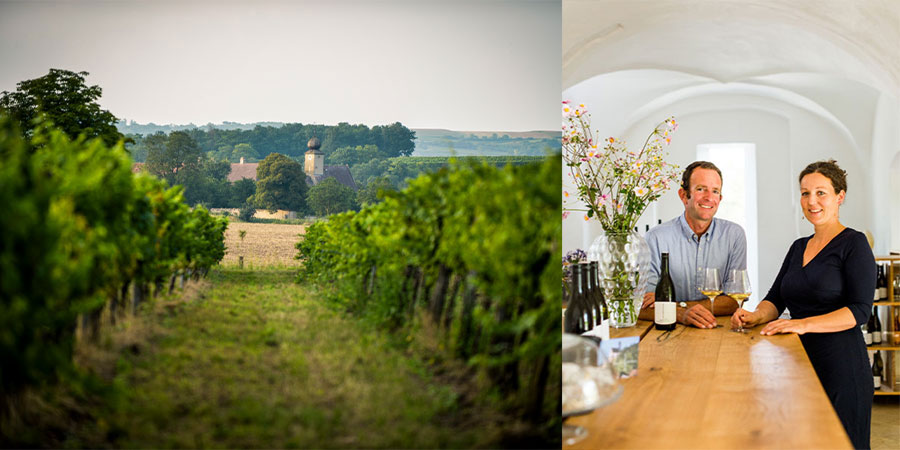

Photos courtesy of Fritz Salomon
Wild Child
In the 19th century, roter veltliner was widely grown and enjoyed a far better reputation than “grüner.” (In fact, Plinia austriaca—so named for its ubiquity even in an era dominated by field blends—began getting called “grüner muskateller” and later “grüner veltliner” in an effort to associate it with unrelated but allegedly more noble grape lineages.) Today, the Wagram is home to nearly half of Austria’s roughly 500 remaining acres of roter veltliner, and to a majority of this grape’s champions. There is considerable support for writing it into a future Wagram DAC, even though roter veltliner represents a mere three percent of Wagram vine surface. Its red berries generate wine frequently featuring rhubarb-like tartness, parsnip pungency and orange-zest piquancy. Along with those come fascinatingly musky floral and savory animal or vegetal elements. (Think roasted red pepper).
Proponents of roter veltliner have come to view this gangly, unruly, hard-to-tame vine not just as the antidote to any soporiferous vinous softness that might arise from loess. They find it singularly suited for the future in view of its acid retention and drought resistance. Especially in places where faster-draining red gravel underlies the loess, it outperforms grüner veltliner. Those growers who recently succeeded in having “Danube Terraces Roter Veltliner” inducted into Slow Food’s “Presidium”—a campaign spearheaded by Hans Czerny—committed themselves to each pursuing an “estate line” through mass selection, promoting those characteristics that made this grape’s former reputation. Toni Söllner relates how, in the 1990s, “we found in a vineyard that was already 80 years old, a loose-clustered variant that we selected and eventually made available to other growers.” Loose clusters are essential for foiling botrytis, which some growers still take for granted in roter veltliner, and which has resulted in an unfair reputation for inherently high alcohol.
“I was fascinated even as a child by this grape,” Söllner says of roter veltliner. In 1989, it became the first variety he vinified, at age 16. Today, he bottles three examples. Even though the vines in his Eisenhut vineyard are relatively young, Söllner’s mass selection already rewards with wines marrying seductive textural richness with billowing buoyancy. The inaugural 2006 was still fresh a dozen years after bottling. The “Irden im Stein” ferments with its skins for eight weeks in 600-liter steinzeuge (antique enameled earthenware crocks), then gets racked to Söllner’s oldest cask—gifted new to his grandfather in 1949 for having saved growers and their wine from Soviet pillage. The wine emerges two years later penetratingly high-toned, glycerol-rich yet tangy, and mind-bendingly complex.
Roter veltliner’s climatically and stylistically adaptive potential is making converts in promising quarters. The ranks of long-time supporters—which, besides Czerny and Söllner, include Franz Leth and Josef Fritz—have recently been enthusiastically joined by veteran vintner Karl Fritsch and his neighbor Fritz Salomon. Four of these six farm biodynamically and favor low-intervention vinification and élevage, which may help account for some of their bottlings being disqualified by the official tasting panels from labeling for their region of origin. That’s unfortunate, because these wines are worthy ambassadors for the Wagram.
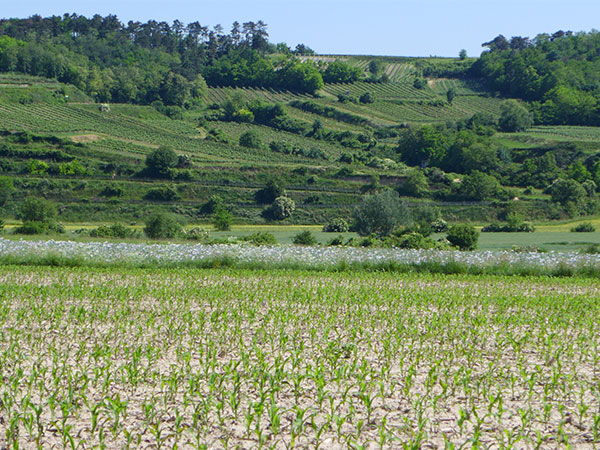

Photo by David Schildknecht
Safety – and Beauty – in Numbers
Hedging one’s bets against the vicissitudes of weather was the principle aim behind Gemischte Sätze (field blends) such as dominated Austrian vineyards before the 20th century, and what few of these remain in the Wagram seem to be finding eager new custodians. In 2015, Kamptal grower Barbara Öhlzelt adopted one such ancient plot located almost on Bernard Ott’s doorstep in Feuersbrunn. Dominated by grüner veltliner, roter veltliner, neuburger, pinot blanc and sylvaner, it consistently combines meadow-like floral and grassy profusion with salad-like crunch and refreshment. And although Ott is proud of his father having been among the first in his region to replace mixed plantings with grüner veltliner, he recently adopted one Gemischter Satz (on the Kamptal border) and has even planted a new one.
Josef Ehmoser beat him by a year, harvesting in 2017 the first fruit from vines growing beneath the wooded site of an old fortress outside Grossweikersdorf. Ehmoser elected to limit himself to eight traditional Austrian favorites: grüner veltliner, pinot blanc, pinot gris, chardonnay, gewürztraminer, zierfandler, rotgipfler and neuburger. But to enhance historical authenticity, he planted them randomly. The first, full-bodied results—raised in cask and concrete egg—indeed conjure a collaboration of champions.
Synergy among grape varieties need not, of course, be limited to those inter-planted. Two remarkable recent exercises in co-fermentative maceration and long élevage of multiple varieties happen to grow nearly next door to one another in Oberstockstall, once home to some of the Passau bishopric’s best vineyards. Fritz Salomon—whose Gut Oberstockstall is dominated by the Passauers’ late 13th-century chapel, beneath which, in 1980, a tunnel was found leading to an intact 16th-century alchemist’s laboratory—began producing his “Oran” in 2014, co-fermenting grüner veltliner with smaller amounts of riesling, traminer and chardonnay for results of dizzyingly diverse aromatics, tongue-tingling vibrancy and improbable alcoholic levity. Karl Fritsch launched his “Materia Prima” that same year, co-fermenting traminer and grüner veltliner in concrete egg with results that are floridly aromatic, palpably extract-rich, phenolically gripping, yet under 12 percent alcohol.
Nor should grapes from outside of Lower Austria’s usual toolbox be ruled out for expressing a Wagram identity. Diwald has recently scored success with furmint, likely the first ever to have been planted north of the Danube. Toni Söllner, putting his trust in Wagram terroir, emphasizes that “varietal diversity is a very, very important tool” for the future and is putting that belief into surprising action. It’s not just that his “Irden” is no longer labeled as roter veltliner because, increasingly, more than 15 percent of its volume comes from other grapes. “At our estate,” he explains, “we already have donauveltliner, donauriesling, sauvignon gris, as well as some other fungus-resistant ‘PIWI’ varieties in production, and we’re very happy with the wine quality. In future, we would prefer to drop varietal designations and simply offer wines suitable to our soil, sites and climate—wines of harmony, finesse and drinkability. How and with what grape varieties—that’s more a matter like with good cooking.”
When the history of early 21st-century viticulture is written, revival and innovation may be seen as seamlessly joined. In the face of climate change, prudence and audacity may appear as two sides of the same coin. And viticultural developments in the Wagram may be acknowledged as having lived up to the region’s name: a watershed.
This feature was brought in front of the paywall as part of our Regional Tasting Report on Austria.
David Schildknecht has followed German wines for several decades, both as a wine buyer at Vintner Select and as a longtime writer for publications including Wine & Spirits, The World of Fine Wine and Austria’s Vinaria.
This story appears in the print issue of April 2021.
Like what you read? Subscribe today.


